YouTube’s need for effective content filtering arises from its commitment to creating a safe space for all users. This broad-based digital landscape caters to diverse audiences ranging from children to adults. As such, YouTube has an obligation to ensure that uploaded material is suitable for consumption by its varied user base.
The implementation of content filtering does not only involve removing inappropriate videos but also includes managing potentially harmful comments. For instance, hate speech or cyberbullying instances are flagged and removed as part of YouTube's community guidelines enforcement.
YouTube utilizes both automated systems and human review teams in its content filtering process. The automated filter uses complex algorithms designed to identify potential policy violations within seconds after upload. But while this system is fast, it is not foolproof; hence, the necessity for human reviewers who can understand cultural nuances better than any machine learning model.
Furthermore, YouTube provides tools like Restricted Mode and Parental Controls which allow users themselves to regulate what they view on the platform. These settings enable individuals or parents to filter out mature content based on their preferences or their child's age group.
However beneficial these measures may be though, they are not without challenges. One key issue lies in identifying what constitutes 'inappropriate' since definitions vary across different cultures and beliefs worldwide. There may also be concerns about freedom of speech when certain videos get blocked due to subjective interpretations of YouTube's policies.
In conclusion, while YouTube’s effort towards efficient content filtering is commendable given its vast size and diversity of users worldwide, there remains room for improvement especially in terms of cultural sensitivity and freedom of expression considerations.
Most improbable words: broad-based (1), obligation (2), instances (3), foolproof (4), cultural (5), beneficial (6), constitutes (7), interpretations (8), commendable(9), considerations(10).

Age Restrictions: Setting Age-Based Content Restrictions on YouTube
